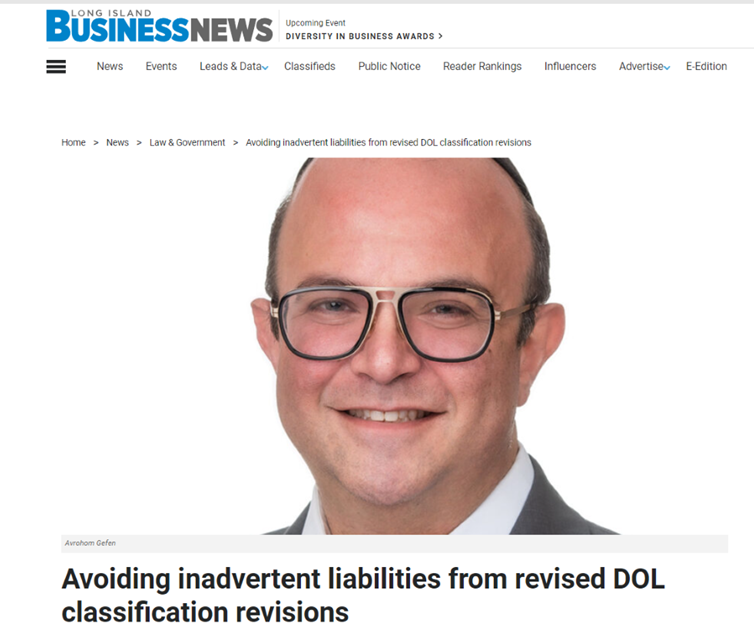VMM partner Avrohom Gefen, head of the firm's Employment Law and Commercial Litigation practices, was invited by Long Island Business News (LIBN) to explain the Department of Labor's new classification of employees vs. independent contractors, and the inadvertent liabilities that could result from misclassification.
The article appeared yesterday in print on February 16 and online yesterday. It can be read here and below.

By Avrohom Gefen, Esq.
If you’re a business owner with workers, it can be tempting to classify them as “independent contractors” rather than employees. Independent contractors are exempt from minimum wage and overtime rules, and you can save on expenses such as payroll taxes and Workers’ Compensation premiums. Some workers even request this classification, because it may allow them to take certain deductions on their tax returns.
But following a new U.S. Department of Labor rule, if your business issues workers 1099s instead of W2s, you're likely misclassifying them and opening yourself up to liability, including personal liability.
The DOL recently revised its guidance on who’s considered an employee and who’s an independent contractor under the Fair Labor Standards Act (FLSA). The DOL believes it will “reduce the risk that employees are misclassified as independent contractors, while providing added certainty for businesses that engage (or wish to engage) with individuals who are in business for themselves.”
The new rule establishes a six-factor analysis of a worker’s relationship with an employer, referred to as the Economic Realities Test:
1. The opportunity for profit or loss a worker might have from the work
- Can the worker meaningfully negotiate the charge or pay for the work provided?
- Can the worker accept or decline jobs or choose the order and/or time in which they’re performed?
- Does the worker engage in marketing, advertising, or other efforts to expand their own business or secure more work?
- Does the worker hire others, purchase materials and equipment, and/or rent space?
2. The financial stake a worker has in the work
- Has the worker made the types of investments that would allow them to operate independently in their industry or field?
- Does the worker purchase their own equipment?
- Does the worker rent their own space?
- Does the worker spend money to market their services?
3. The degree of permanence of the work relationship
- Is the worker working regularly occurring, fixed periods (even seasonally)?
4. The degree of control an employer has over the worker’s work
Does the business set the worker's schedule?
- Does the business supervise the performance of the work?
- Does the business limit the worker's ability to work for others, either explicitly or by placing demands or restrictions that wouldn’t allow them to work for others, or work when they choose?
- Does the business have the right to supervise or discipline the workers?
5. Whether the work the person does is essential to the business
- Is the work performed by the worker necessary or central to the employer's principal business?
6. Whether the worker uses specialized skills, and do those skills contribute to business-like initiative
- Does the worker have specialized skills and markets those skills, for example, to generate new business?
Complicating things, the IRS applies its own test to determine if a worker is an employee or independent contractor. A worker can be classified as an independent contractor for tax purposes, but as an employee for DOL purposes.
The potential liabilities for worker misclassification are high. If a worker is incorrectly classified as an independent contractor, the employer will be responsible for paying any unpaid wages owed under the FLSA, including minimum wage and overtime. The employer will also likely have to pay liquidated damages in an amount equal to back wages, civil money penalties, and attorneys’ fees if the worker files a private lawsuit.
The employer may also be liable not only for unemployment and workers' compensation premiums for the particular worker, but for all other "similarly situated" workers. As with most employment-related violations, there may also be personal liability, especially if it's an owner-managed business.
The new DOL rule is effective March 11, 2024. If your business issues 1099s to any workers, you should proactively review your situation and consider whether they should be reclassified as employees.



